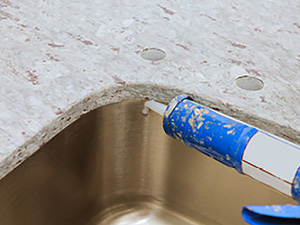Countertop Caulking
One of the biggest investments in a home is the kitchen. The right flooring, along with the paint, cabinets, appliances, and countertops can result in a hefty price tag. And yet, one of the smallest and easiest things to fix can be the cause of costly damage to your investment. You need to fix those cracks and gaps in your kitchen caulk.
When your stone countertop was installed, several areas were caulked. The bottom of the backsplash where it meets the countertop. The top of the backsplash where it meets the wall or tile. The gap between the sink and countertop, and the seams where two pieces of countertop come together. If you don’t have a backsplash, then caulk was used to fill in the gap between the countertop and wall.
Why does my countertop need caulking?
- It looks better than leaving a raw edge.
- It looks better than having a noticeable gap.
- It’s an extra step to help hold the parts and pieces still.
- Filling the gaps helps to prevent water and other spills from running behind or through your countertops to your walls and cabinets.
What causes caulk to crack and gap?
- If your home is new construction, settling may be the reason you are seeing cracks or gaps in your caulk lines.
- Change of the seasons is another culprit, especially if your countertop rests on an outside wall. Cabinets and walls shrink and swell with seasonal changes, and heat and humidity.
- Maybe your cabinets were not level, square, and plum when the countertops were installed so there is undue tension on the countertop causing it to minutely shift.
- Overscrubbing can also be an issue, especially since latex caulk can get moldy.
- Normal wear and tear can be a key factor in causing gaps and cracks, as well.
What kind of damage can happen?
No matter how it happened, once you see those cracks and gaps, you should have them taken care of promptly to prevent any type of cabinet or wall damage. Gaps in the seam between two pieces of stone countertop can allow water or other liquids to run into the cabinets below. The same is true of gaps in the caulking material that helps adhere your sink to your countertop. Leaking water can damage your cabinets. Gaps and cracks at the backsplash can allow water and other liquids to seep through and run down your walls, damaging the drywall over time.
If you decide to take care of this yourself, be aware that different joints require different material.
- The gap between the sink and countertop requires 100% silicone.
- The joint at the bottom of the backsplash also needs 100% silicone.
- If the stone meets a tile backsplash, you should use either 100% silicone or sanded color caulk to match the grout as closely as possible.
- The gap at the top of the backsplash where it meets the drywall should have either 100% silicone or paintable caulk.
- If the issue is between two pieces of countertop, a two-part epoxy, custom tinted to match the countertop color is needed.
Caulk is a little thing that most people tend to ignore. However, caulk can play a key role in protecting one of your biggest home investments: your kitchen. Make sure your caulking is in good condition. If your caulking needs to be redone, don’t put off taking care of it. If you aren’t exactly sure what you need to do, then give us a call. It’s best to take care of the small things now so they don’t become big problems later.
By Sharon Koehler. This article is one of a series of articles written and published on behalf of Surface Care PRO Partners.

